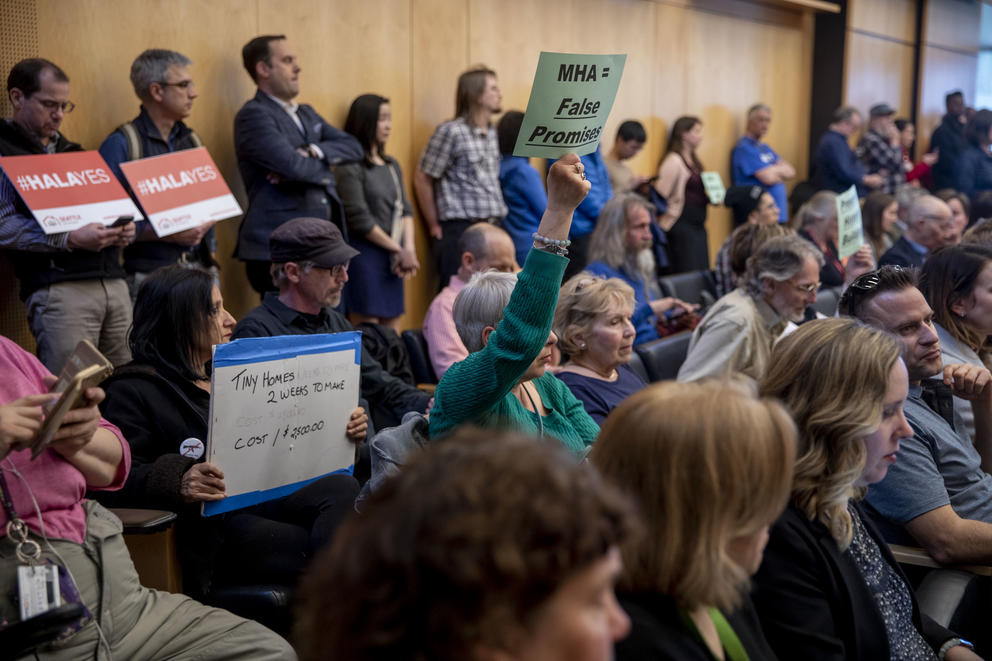After years of discussion, public comment on this final day of debate over the program fell along familiar lines. There were last-ditch calls for the council to delay its vote, with speakers citing concerns over gentrification, lost trees and blocked views. Supporters voiced thanks to council members for shepherding MHA through to this vote and shared hopes that the legislation would move the needle on Seattle’s affordable housing and homelessness crisis. For council members, it was a victory lap after a yearslong grind.
“After four long years of legislative and legal processes, I believe we’ve arrived at a place where we say yes to more density, yes to more housing and yes to more neighbors in 27 communities in Seattle,” Councilmember Lorena González said Monday. “For some this legislation goes too far. For some it doesn’t go far enough.”
The MHA program “upzones” parts of Seattle, allowing residential and commercial developers to build larger buildings that, in theory, provide a more profitable return on their investment. In exchange for that increased density, those developers must either build affordable housing into their project or pay into the city’s affordable housing fund, which will be used to develop affordable housing elsewhere.
Introduced as the “Grand Bargain” between new market-rate development and affordable housing, MHA was the centerpiece of then-Mayor Ed Murray’s Housing Affordability and Livability Agenda (HALA), a collection of 65 recommendations for addressing the housing crisis.
The policy has served as a lightning rod in the midst of Seattle’s rapid population boom and the accompanying spike in the cost of living.
Supporters, including city council members, affordable housing developers and density advocates, say MHA is a balanced approach to growth that will create much-needed affordable housing while allowing for construction of more market-rate housing to meet increasing demand.
Some detractors, many of them homeowners in Seattle, fear the upzones will irrevocably change the single-family neighborhoods that make up so much of Seattle without creating enough affordable housing to address actual need. On the other side of the same coin, some pro-development skeptics of MHA say it will hinder construction by adding excessive fees, defeating the city’s stated goal of building housing to meet the demands of a growing population.
MHA spent a year in legal limbo after 26 neighborhood groups called Seattle Coalition for Affordability, Livability, Equity (SCALE) appealed to the city hearing examiner on the grounds that the city had done insufficient analysis of MHA’s impact.
Today’s vote is not the council’s first go at MHA. As a forerunner to the citywide version, Seattle has already implemented MHA in six neighborhoods – Downtown, Belltown, South Lake Union, Chinatown-International District, University District, and at three intersections along 23rd Avenue in the Central District.
On Monday, the council adopted the citywide version of MHA. Though the “citywide” name makes it sound like all of Seattle is about to be upzoned, the new policy affects 27 neighborhood urban villages, leaving much of the city untouched.
Another misperception is that MHA is a uniform upzone that will allow high rises throughout Seattle. Each neighborhood is getting a variety of changes, depending on existing zoning. In many cases, each zone is essentially getting one notch denser.
For example, in the Rainier Beach neighborhood along Rainier Avenue, neighborhood commercial zones are changing from a maximum building height of 40 feet to 55 feet. At Jackson Street and 20th Avenue in the Central District, commercial buildings can now be 75 feet instead of 65 feet. Existing low-rise zones that allow duplexes, triplexes and small apartment buildings will get denser, as well. In Low Rise 2 zones, backyard cottages can be up to 22 feet high instead of the current 18 feet, and apartment buildings can be four stories instead of three.
Arguably the most controversial changes are those affecting Seattle’s single-family neighborhoods, where one home is allowed per lot. According to the city, only about 6 percent of single-family neighborhoods in Seattle will be changed under MHA. In most cases, those single-family zones will change to a newly created designation called Residential Small Lot. This designation allows for multiple standalone “cottage” homes to be built on the same lot, as well as the creation of duplexes and row houses. In some cases, single-family zones are getting bumped up to a Low Rise 1 or 2, which will allow triplexes, townhomes, row houses and three- to four-story apartment buildings with 20 to 30 units in them.
Get daily news in your inbox
This newsletter curates some of the most important headlines of the day from Crosscut and other news outlets.
So what does the city get after years of wrangling?
The city estimates citywide MHA will create 3,000 rent-restricted affordable homes through a mix of developer payments and on-site construction. Coupled with MHA already in place in six neighborhoods, the program is supposed to create 6,000 units of affordable housing over the next decade.
“That is a huge deal,” said Councilmember Rob Johnson. “I sat on a regional housing task force for the last few years that came up with a recommendation for 44,000 units of income-restricted affordable housing over the next five years [throughout King County]. MHA has got to be one of the key Seattle strategies to meet our fair share of that goal.”
Though MHA has sucked up a lot of the political oxygen around affordable housing in recent years, it is far from enough to meet Seattle’s need. The 2015 HALA report set a goal of creating 50,000 new units of housing over 10 years, 20,000 of which are supposed to be subsidized affordable housing.
“When you talk to the general public they tend to equate HALA and MHA,” said Marty Kooistra, executive director of Housing Development Consortium, a nonprofit advocacy group. “MHA is just one tool in the tool chest. We are constantly working on a whole array of things that include the use of the housing levy [to fund housing projects], finding ways to modify tenant protections, … looking to the state on a number of things this legislative session that will feed into our success in creating as many units as we can.”
Councilmember Sally Bagshaw put it bluntly on Monday. “I regard this as a very important drop in the bucket, frankly,” she said.
MHA critics like Fremont Neighborhood Council president Toby Thaler, one of the appellants with SCALE, don’t think the program will create enough affordable housing and, because developers can pay an in-lieu fee rather than building affordable housing onsite, say MHA will lead to low-income residents being displaced.
“MHA will cause the loss of more existing affordable housing in many neighborhoods than will be created there,” Thaler said, “both because it doesn’t require inclusion in those neighborhoods and because the fees are too low.”
It’s true that much of the affordable housing created by MHA will come through in-lieu payments into the city’s affordable housing fund, meaning the affordable housing built won’t necessarily be in the neighborhood that generated the MHA payment. Councilmember Lisa Herbold and Mayor Jenny Durkan are both working on policies to address displacement.
And though the MHA upzones could encourage development by making it more profitable in some cases, development and displacement have been happening throughout Seattle during the past several years of economic boom without MHA in place. A study by the Office of Planning and Community Development calculated that delaying citywide MHA implementation resulted in the loss of between 653 and 717 units of affordable housing that would have been funded or built by developments that were permitted or constructed while the policy was under city hearing examiner review.
“We really missed out,” said Laura Bernstein with the pro-housing group Share the Cities. “Roosevelt is a perfect example. If we’d just enacted MHA and not gone through this drawn-out nonsense, we would’ve gotten affordable housing contribution from all that Roosevelt development happening around the future light rail station.”
At Monday’s meeting, Councilmember Teresa Mosqueda said that without MHA the development already happening in the city doesn’t do anything to address the problem.
“We know that change and development is inevitable,” she said. “Change and development are happening right now. Because we haven’t been able to include MHA [in that development], that change hasn’t been what our communities have wanted.”
In theory, today’s vote moves the years of planning, outreach and legal fights into the past, and puts MHA to work in 27 neighborhoods around Seattle. But there is still a chance more lawsuits are coming from neighborhood groups not ready to give up the fight. Thaler said he couldn’t discuss specifics, but said, “It’s obvious there’s potential for an appeal to the Growth Management Act board."







